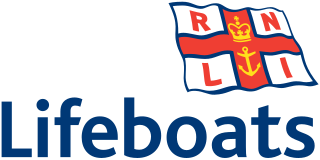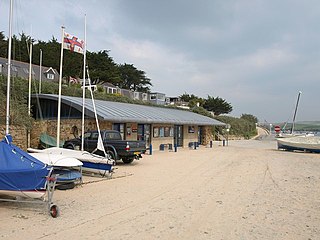
The Royal National Lifeboat Institution (RNLI) is the largest of the lifeboat services operating around the coasts of the United Kingdom, the Republic of Ireland, the Channel Islands, and the Isle of Man, as well as on some inland waterways.

The Oakley-class lifeboat refers to two types of self-righting lifeboat operated by the Royal National Lifeboat Institution (RNLI) around the coast of the United Kingdom and Ireland between 1958 and 1993. The 37-foot (11.3 m) Oakley was designed for carriage launching, while the larger 48-foot-6-inch (14.8 m) version was designed for slipway launching or to lie afloat. During their service they saved a combined total of 1,456 lives in 3,734 rescue launches.

Dart Lifeboat Station is the base for Royal National Lifeboat Institution (RNLI) inshore lifeboat operations at Dartmouth, Devon in England. The present station was opened in 2007 although an earlier lifeboat was stationed in the town from 1878 to 1896. It operates a D-class (IB1) inshore lifeboat, and a B-class inshore lifeboat.

Appledore Lifeboat Station is the base for Royal National Lifeboat Institution (RNLI) search and rescue operations at Appledore, Devon in the United Kingdom. The first lifeboat was stationed in the town in 1825 and the present station was opened in 2001. It operates a Tamar-class all-weather boat (AWB) and an Atlantic 85 B Class inshore lifeboat (ILB).

St Ives Lifeboat Station is the base for Royal National Lifeboat Institution (RNLI) search and rescue operations at St Ives, Cornwall in the United Kingdom. The first lifeboat was built for the town in 1840 and the present boathouse was opened in 1994. It operates a Shannon-class all weather boat (AWB) and a D-class (IB1) inshore lifeboat (ILB).

Ilfracombe Lifeboat Station is the base for Royal National Lifeboat Institution (RNLI) search and rescue operations at Ilfracombe, Devon, England. The first lifeboat was stationed in the town in 1828 and the present station was opened in 1996. For 29 years a second boat was operated from Morte Bay at Woolacombe.
Lynmouth Lifeboat Station was the base for Royal National Lifeboat Institution (RNLI) search and rescue operations at Lynmouth, Devon in England from 1869 until 1944. Its best known action was in 1899 when the lifeboat was taken 15 miles (24 km) across Exmoor before being launched to assist a ship in trouble.

Salcombe Lifeboat Station is the base for Royal National Lifeboat Institution (RNLI) search and rescue operations at Salcombe, Devon in England. The first lifeboat was stationed in the town in 1869. The Salcombe Lifeboat has twice capsized, in 1916 with the loss of 13 lives, and in 1983 with no loss of life. Since 2008 the station has operated a Tamar-class all weather boat (ALB) and an Atlantic 75 inshore lifeboat (ILB).

Teignmouth Lifeboat Station is the base for Royal National Lifeboat Institution (RNLI) search and rescue operations at Teignmouth, Devon in England. The first lifeboat was stationed in the town in 1851 but the station was closed from 1940 until 1990. Since 2006 it has operated an Atlantic 85 inshore lifeboat (ILB).

Sennen Cove Lifeboat Station is the base for Royal National Lifeboat Institution (RNLI) search and rescue operations for the sea around Land's End, Cornwall in the United Kingdom. The first lifeboat was stationed at Sennen Cove in 1853. Since 2009 it has operated a Tamar-class all weather boat (ALB) and a D-class (IB1) inshore lifeboat (ILB).
Torquay Lifeboat Station was the base for Royal National Lifeboat Institution (RNLI) search and rescue operations at Torquay, Devon in England from 1876 until 1923. A second lifeboat was kept at the harbour from 1917 until 1928.

Calshot Lifeboat Station is located on Calshot Spit near the village of Calshot, Hampshire, and is on the southern bank of the open end of Southampton Water, on the south coast of England. The station is owned and operated by the Royal National Lifeboat Institution (RNLI) and operates two inshore lifeboats: an B-class and a D-class (IB1).

Port Isaac Lifeboat Station is the base for Royal National Lifeboat Institution (RNLI) inshore lifeboat operations at Port Isaac in Cornwall, United Kingdom. It operates a D-class (IB1) lifeboat, which since 2019 has been the Pride of Port Isaac .

Hope Cove Life Boat was formed in 1878 and is a voluntary search and rescue service that operates an inshore rescue boat in the Bigbury Bay area.

Plymouth Lifeboat Station is the base for Royal National Lifeboat Institution (RNLI) search and rescue operations at Plymouth in England. The first lifeboat was stationed in the city in the early 1800s. The station moved to its present site at Millbay Docks in 1992, a Grade II-listed three-storey tower. Since 2003 it has operated a Severn-class all-weather boat (ALB) along with an B-class Atlantic inshore lifeboat (ILB).

Barmouth Lifeboat Station is located in Barmouth, a town at the mouth of the Afon Mawddach river in Gwynedd, Wales. A lifeboat was first stationed here by the Royal National Institute for the Preservation of Life from Shipwreck (RNIPLS) in 1828.

Newquay Lifeboat Station is the base for Royal National Lifeboat Institution (RNLI) search and rescue operations at Newquay, Cornwall, in the United Kingdom. It operates two lifeboats, Atlantic 85 The Gladys Mildred (B-821) and D-class (IB1) Enid Mary (D-773).

Bude Lifeboat Station is the base for Royal National Lifeboat Institution (RNLI) search and rescue operations at Bude, Cornwall in the United Kingdom. It operates a D-class (IB1) lifeboats, which since 2012 has been the George Bird (D-756).

Rock Lifeboat Station is the base for Royal National Lifeboat Institution (RNLI) search and rescue operations on the River Camel in Cornwall, United Kingdom. It operates a D-class (IB1) lifeboat, which since 2014 has been the Rusper II.
Steam-class lifeboats are a small group of six steam powered lifeboats, and one steam-tug lifeboat, built between 1889 and 1901.

















